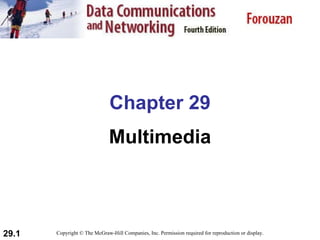
Chapter 29 - Mutimedia
- 1. Chapter 29 Multimedia Copyright © The McGraw-Hill Companies, Inc. Permission required for reproduction or display.
- 2. Figure 29.1 Internet audio/video
- 3. Streaming stored audio/video refers to on-demand requests for compressed audio/video files. Note
- 4. Streaming live audio/video refers to the broadcasting of radio and TV programs through the Internet. Note
- 5. Interactive audio/video refers to the use of the Internet for interactive audio/video applications. Note
- 6. 29-1 DIGITIZING AUDIO AND VIDEO Before audio or video signals can be sent on the Internet, they need to be digitized. We discuss audio and video separately. Digitizing Audio Digitizing Video Topics discussed in this section:
- 7. Compression is needed to send video over the Internet. Note
- 8. 29-2 AUDIO AND VIDEO COMPRESSION To send audio or video over the Internet requires compression. In this section, we discuss audio compression first and then video compression. Audio Compression Video Compression Topics discussed in this section:
- 9. Figure 29.2 JPEG gray scale
- 10. Figure 29.3 JPEG process
- 11. Figure 29.4 Case 1: uniform gray scale
- 12. Figure 29.5 Case 2: two sections
- 13. Figure 29.6 Case 3: gradient gray scale
- 14. Figure 29.7 Reading the table
- 15. Figure 29.8 MPEG frames
- 16. Figure 29.9 MPEG frame construction
- 17. 29-3 STREAMING STORED AUDIO/VIDEO Now that we have discussed digitizing and compressing audio/video, we turn our attention to specific applications. The first is streaming stored audio and video. First Approach: Using a Web Server Second Approach: Using a Web Server with a Metafile Third Approach: Using a Media Server Fourth Approach: Using a Media Server and RTSP Topics discussed in this section:
- 18. Figure 29.10 Using a Web server
- 19. Figure 29.11 Using a Web server with a metafile
- 20. Figure 29.12 Using a media server
- 21. Figure 29.13 Using a media server and RTSP
- 22. 29-4 STREAMING LIVE AUDIO/VIDEO Streaming live audio/video is similar to the broadcasting of audio and video by radio and TV stations. Instead of broadcasting to the air, the stations broadcast through the Internet. There are several similarities between streaming stored audio/video and streaming live audio/video. They are both sensitive to delay; neither can accept retransmission. However, there is a difference. In the first application, the communication is unicast and on-demand. In the second, the communication is multicast and live.
- 23. 29-5 REAL-TIME INTERACTIVE AUDIO/VIDEO In real-time interactive audio/video, people communicate with one another in real time. The Internet phone or voice over IP is an example of this type of application. Video conferencing is another example that allows people to communicate visually and orally. Characteristics Topics discussed in this section:
- 24. Figure 29.14 Time relationship
- 25. Jitter is introduced in real-time data by the delay between packets. Note
- 26. Figure 29.15 Jitter
- 27. Figure 29.16 Timestamp
- 28. To prevent jitter, we can time-stamp the packets and separate the arrival time from the playback time. Note
- 29. Figure 29.17 Playback buffer
- 30. A playback buffer is required for real-time traffic. Note
- 31. A sequence number on each packet is required for real-time traffic. Note
- 32. Real-time traffic needs the support of multicasting. Note
- 33. Translation means changing the encoding of a payload to a lower quality to match the bandwidth of the receiving network. Note
- 34. Mixing means combining several streams of traffic into one stream. Note
- 35. TCP, with all its sophistication, is not suitable for interactive multimedia traffic because we cannot allow retransmission of packets. Note
- 36. UDP is more suitable than TCP for interactive traffic. However, we need the services of RTP, another transport layer protocol, to make up for the deficiencies of UDP. Note
- 37. 29-6 RTP Real-time Transport Protocol (RTP) is the protocol designed to handle real-time traffic on the Internet. RTP does not have a delivery mechanism; it must be used with UDP. RTP stands between UDP and the application program. The main contributions of RTP are time-stamping, sequencing, and mixing facilities. RTP Packet Format UDP Port Topics discussed in this section:
- 38. Figure 29.18 RTP
- 39. Figure 29.19 RTP packet header format
- 40. Table 20.1 Payload types
- 41. RTP uses a temporary even-numbered UDP port. Note
- 42. 29-7 RTCP RTP allows only one type of message, one that carries data from the source to the destination. In many cases, there is a need for other messages in a session. These messages control the flow and quality of data and allow the recipient to send feedback to the source or sources. Real-time Transport Control Protocol (RTCP) is a protocol designed for this purpose. Sender Report and Receiver Report Messages UDP Port Topics discussed in this section:
- 43. Figure 29.20 RTCP message types
- 44. RTCP uses an odd-numbered UDP port number that follows the port number selected for RTP. Note
- 45. 29-8 VOICE OVER IP Let us concentrate on one real-time interactive audio/video application: voice over IP, or Internet telephony. The idea is to use the Internet as a telephone network with some additional capabilities. Two protocols have been designed to handle this type of communication: SIP and H.323. SIP H.323 Topics discussed in this section:
- 46. Figure 29.21 SIP messages
- 47. Figure 29.22 SIP formats
- 48. Figure 29.23 SIP simple session
- 49. Figure 29.24 Tracking the callee
- 50. Figure 29.25 H.323 architecture
- 51. Figure 29.26 H.323 protocols
- 52. Figure 29.27 H.323 example
